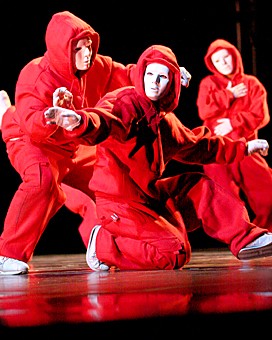A group of UA students is using hip-hop dance to give local teens a tool against drugs and violence while showing them the artistic element of street dance.
Culture Rhythm Dance Crew, established in the spring of 2005 by molecular and cellular biology senior Aki Sugiyama, uses hip-hop-style dance as a positive outlet for Tucson teens.
Sugiyama, who is originally from Los Angeles, said dance gave him a safe haven from drugs and gangs when he was younger, and the Dance Crew is his way of giving back to the community.
“”My friend changed and went into bad stuff,”” Sugiyama said. “”Dance kept me away.””
When Sugiyama transferred to the UA in 2004, the absence of hip-hop dance on campus inspired him to start his own dance troupe. Sugiyama got two friends together, one who was a dance major, and started the Dance Crew.
Marquez Johnson, a pre-communication sophomore and president of the Dance Crew, said hip-hop-style dance is popular because anyone can learn to do it.
“”To me, hip-hop dance is what comes naturally,”” Johnson said. “”When people are allowed to dance naturally, it’s more fun.””
The Dance Crew members are quickly making a name for themselves in a culture usually reserved for pirouettes and arabesques, having already performed more than a dozen shows.
“”People have a negative impression of hip-hop. They see baggie pants and think bad stuff,”” Sugiyama said. “”They just don’t know the culture.””
The culture, Sugiyama said, envelops not just music but also fashion and dance.
“”Hip-hop is not just entertainment,”” Sugiyama said. “”There is definitely an artistic element to it.””
The artistic element can be seen in the Dance Crew’s latest number, which was performed over the weekend as part of the School of Dance “”Spring Collection.””
Dressed in red hoodies and red sweats, the Dance Crew wore Jason-like horror masks and white gloves to match their white sneakers – all combining to give an eerie feeling to the performance.
A music mix of relatively simple beats with a classical sound bumped in the background while the Dance Crew performed old-school breakdance moves like popping and locking. They also added an artistic element by visually expressing the music and timing moves to the beat.
“”(The piece) is trying to show every aspect of hip-hop,”” Sugiyama said. “”It’s a free dance. There are no restrictions to it.””
Sugiyama said he thinks of a hip-hop dance piece in the form of yin and yang – half artistic and half entertainment.
While the Dance Crew will continue performing in shows, Sugiyama said they also plan to start visiting local middle schools and high schools to give students a quick lesson in street dance and also make them aware of local hip-hop dance classes.









